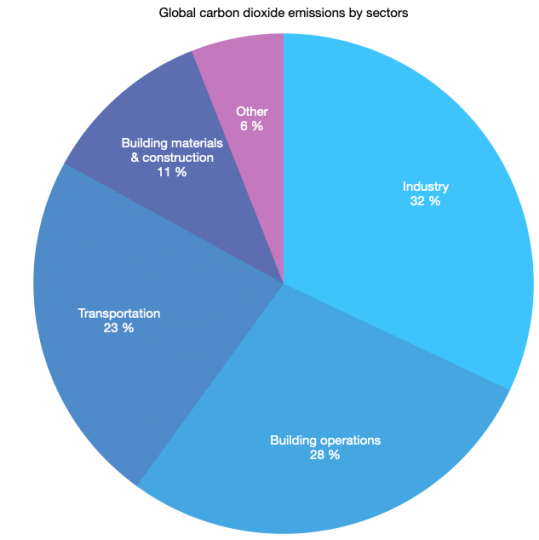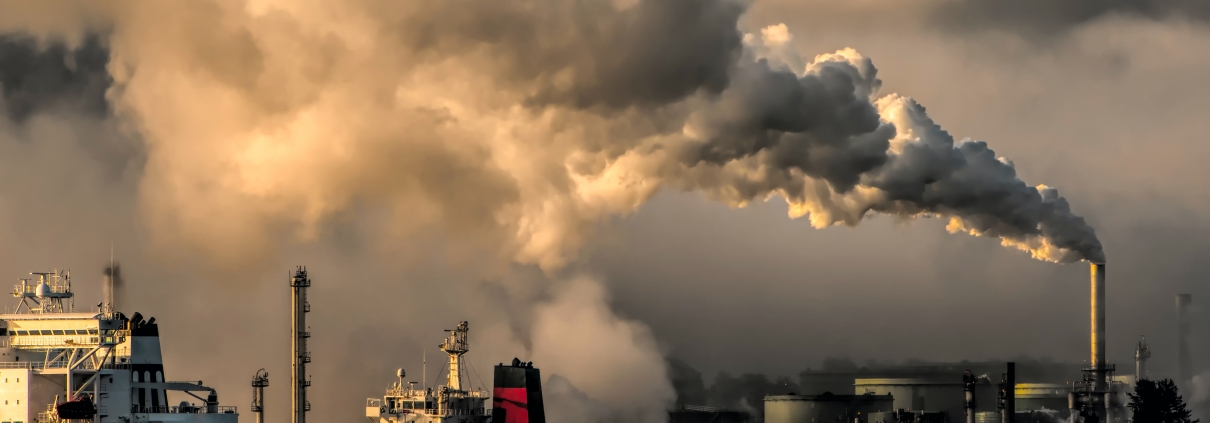Everything to know about carbon dioxide (CO2)
Carbon dioxide is one greenhouse gas that is a primary driver of global warming emissions. Emissions of CO2 from human activities are also the main driver of this, as it changes the average global temperature. At Breeze Technologies, CO2 can be monitored using our air quality sensors. Read on more to find out why it is important to reduce CO2 emissions.
What is carbon dioxide?
Carbon dioxide (CO2) is a colorless and non-flammable gas at normal temperature and pressure. A molecule of CO2 consists of one carbon atom and two oxygen atoms. CO2 also plays a role in the Earth’s carbon cycle, the set of processes that cycle carbon in many forms throughout the environment.
CO2 is an important heat-trapping (greenhouse) gas which is released through human activities such as deforestation and burning fossil fuels. Without CO2, our planet would be an unlivable environment because it would be very cold. CO2 emissions can also be released from natural processes like respiration and volcanic eruptions.
Is carbon dioxide an air pollutant?
Carbon dioxide is not considered an air pollutant, as it occurs naturally in the air. However, the CO2 concentration in the atmosphere has significantly increased due to human activity. Carbon dioxide is a greenhouse gas; alongside nitrous oxide (N2O), and methane (CH4). Small amounts of greenhouse gases are safe to breathe, however the increase in burning of fossil fuels creates a greenhouse effect. Land use changes due to farming and forestry also lead to an increase in greenhouse gas emissions.
The increase in greenhouse gas emissions causes the average temperatures to continue to rise, warming the climate of our planet. The so-called greenhouse effect increases the global temperature and results in a complex chain of events known as global climate change. Global climate change not only leads to an overall increase in temperatures, but also changes weather patterns and the general climate on Earth.
Outdoors, CO2 is very dispersive with levels not varying by a lot even through a cityscape. Indoors, the story is different: CO2 is one of the main indicators of indoor air quality. As indoor environments are enclosed ecosystems, carbon emissions from people and other sources can quickly accumulate to multiples of the natural atmospheric CO2 concentration.
What are sources of carbon dioxide?
There are both natural and anthropogenic (man-made) sources of CO2 emissions. Natural sources include decomposition, ocean release, respiration, and photosynthesis. Respiration, the process by which organisms liberate energy from food, also emits CO2. Photosynthesis, the biochemical process by which plants and some microbes create food, acts as respiration’s natural counterpart by drawing CO2 from the atmosphere.
Man-made sources of CO2 mainly consist of the burning of fossil fuels, such as coal, oil and gas, by directly releasing the stored carbon into the air while releasing the stored energy as heat. Cement production emits CO2 when using energy from fossil fuels to fire the cement’s base materials in a kiln, and the chemical reaction produced from the mixture when it is exposed to heat. In addition, deforestation also releases stored carbon from forest landscapes into the atmosphere. The reverse process of growing forests and thereby storing surplus carbon in the trees’ trunks and roots is called “sequestration.” Other land use changes such as agriculture and forestry contribute to about 23% of anthropogenic emissions of CO2 as well as other air pollutants.
What is the health impact of carbon dioxide?
Exposure to CO2 can produce a variety of health effects. These may include:
- Headaches
- Dizziness
- Restlessness
- A tingling “pins and needles” feelings
- Difficulty breathing
- Sweating
- Tiredness
- Increased heart rate
- Elevated blood pressure
- Coma
- Asphyxia
- Convulsions
The levels of CO2 in the air can also have various potential health problems, depending on the ranges as follows:
| CO2 level | Air quality indication |
|---|---|
| 419 ppm | Average atmospheric CO2 concentration |
| 419–1,000 ppm | Typical level found in occupied spaces with good air exchange |
| 1,000–2,000 ppm | Level associated with complaints of drowsiness and poor air |
| 2,000–5,000 ppm | Level associated with headaches, sleepiness, and stagnant, stale, stuffy air. Poor concentration, loss of attention, increased heart rate and slight nausea may also be present. |
| 5,000 ppm | Permissible exposure limit for daily workplace exposures. At these level, unusual air conditions where high levels of other gases could also be present. Toxicity or oxygen deprivation could also occur. |
| 40,000 ppm | Levels are immediately harmful due to oxygen deprivation |
What is the environmental impact of carbon dioxide?
CO2 emissions have strong evidence as a greenhouse gas to cause global warming. Climate change will have a range of impacts that causes an increase of the global sea level, extreme weather shifts, shifting wildlife populations and habitats, and a range of other impacts.
One of the human sources originates from the urbanization process. Urbanization is a dynamic process that changes rural areas into urban areas. The built environment provides infrastructure and facilities for human activities but also plays a considerable role in rising CO2 emissions in the building sector. The environmental impact of this sector can be categorized into ecosystem, natural resource, and public impacts.
The figure below represents the total usage of energy and CO2 emissions from the building sector in the developed and developing countries:

How can carbon dioxide be lessened?
There is a strong link between CO2 emissions, prosperity, and standards of living. To demonstrate progress in reducing emissions, countries would have to fulfill two criteria: (1) High standards of living and (2) low levels of emissions, or at least large reductions in emissions to maintain that standard of living.
There are many countries which meet only one criteria: rich countries with high standards of living but also high levels of emissions, or poor countries that have low levels of emissions but poor standards of living.
Two fundamental areas to progress reduction in greenhouse gas emissions are:
- Energy (electricity, heat, transport, and industrial activities)
- Shift towards low-carbon electricity (reduce carbon intensity)
- Shift sectors such as transport towards electricity
- Develop low-cost low-carbon energy and battery technologies
- Improve energy efficiency (energy per unit GDP)
- Food and agriculture (agriculture and land use changes)
- Reduce meat and dairy consumption, especially in higher-income countries
- Promote lower-carbon meat and dairy production
- Improve crop yields
- Reduce food waste
Fighting local air pollution can be the first step and tackling the issue of global warming, as air pollution and climate change can be seen as two sides of the same coin. To tackle this global health threat, Breeze Technologies provides a full-stack solution to monitor, manage and improve local air pollution levels.
You can learn more about air quality in your neighborhood by learning more about your local air quality through your regional or federal government website, or our global citizen portal on air quality. Here, air quality data is typically assessed using an air quality index. Still, air quality data is traditionally gathered only at a few limited locations, which means that the closest data might still be from a place far away from your home. This is why we offer a program to volunteer as an air quality sensor host. Sensors installed near your premises can allow for more accurate and localized air quality information on our free citizen portal for governments and citizens. The more local air quality information there is, the better the clean air actions that can be taken for a healthier life. Join our sensor host program today!



